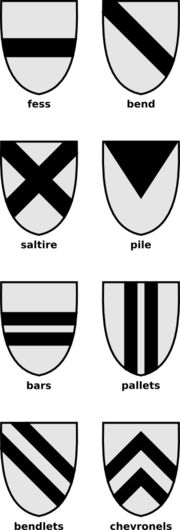Difference between revisions of "Charge(Heraldry)"
(New page: In heraldry and vexillology, a charge is an image occupying the field on an escutcheon (or shield). Charge can also be a verb; for example, if an escutcheon bears three lions, then it ...) |
m (moved Charge to Charge(Heraldry): Disambiguation. Charge now a function of magic and abilities.) |
||
| (3 intermediate revisions by one other user not shown) | |||
| Line 1: | Line 1: | ||
| − | In heraldry and vexillology, a charge is an image occupying the field on an [[escutcheon]] (or shield). Charge can also be a verb; for example, if an escutcheon bears three lions, then it is said to be charged with three lions. It is important to distinguish between [[divisions of the field]] and charges, and to note that charges can themselves be charged with a superimposed image. | + | [[Image:Ordinaries.png|thumb]] |
| + | In [[heraldry]] and vexillology, a charge is an image occupying the field on an [[escutcheon]] (or shield). Charge can also be a verb; for example, if an escutcheon bears three lions, then it is said to be charged with three lions. It is important to distinguish between [[divisions of the field]] and charges, and to note that charges can themselves be charged with a superimposed image. | ||
Sometimes the significance or the allusion behind the charge(s) may be given in the [[blazon]], but this is generally regarded as poor practice. | Sometimes the significance or the allusion behind the charge(s) may be given in the [[blazon]], but this is generally regarded as poor practice. | ||
| Line 11: | Line 12: | ||
Narrower or smaller versions of these ordinaries are called diminutives. | Narrower or smaller versions of these ordinaries are called diminutives. | ||
| − | |||
[[Category: Heraldry Terms]] | [[Category: Heraldry Terms]] | ||
Latest revision as of 21:21, 8 December 2014
In heraldry and vexillology, a charge is an image occupying the field on an escutcheon (or shield). Charge can also be a verb; for example, if an escutcheon bears three lions, then it is said to be charged with three lions. It is important to distinguish between divisions of the field and charges, and to note that charges can themselves be charged with a superimposed image.
Sometimes the significance or the allusion behind the charge(s) may be given in the blazon, but this is generally regarded as poor practice.
Thousands of objects found in nature, mythology or technology have appeared in armory, in addition to charges that are unique to heraldry. This article lists only those charges frequently seen, which contribute to the distinctive flavor of heraldic design; a more exhaustive list will be found at List of heraldic charges.
Charges can be animals (cf. totem), objects or geometric constructs. The ordinaries are sometimes called proper charges, with other charges being known as common charges. In French blazon the ordinaries are called pièces while other charges, which may be placed anywhere on the shield, are called meubles (i.e. "mobile"; the same word also means "furniture" in modern French).
Heraldic writers traditionally distinguish, somewhat arbitrarily, between honourable ordinaries and sub-ordinaries. It is often said that only nine charges are honourable ordinaries, but exactly which nine fit into this category is a subject of disagreement. It is sometimes said that only those ordinaries each of whose widths is one-fifth or more of the total width of the escutcheon is honorable.
Narrower or smaller versions of these ordinaries are called diminutives.
